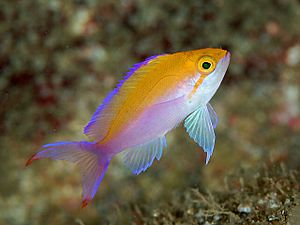Bicolor anthias facts for kids
Quick facts for kids Bicolor anthias |
|
|---|---|
 |
|
| Conservation status | |
| Scientific classification | |
| Synonyms | |
|
The bicolor anthias or yellowback basslet (scientific name: Pseudanthias bicolor) is a beautiful and colorful fish that lives in the ocean. It is a type of ray-finned fish and belongs to the same family as groupers and sea basses. This fish is found in the warm waters of the Indo-Pacific Ocean. Sometimes, people keep them in home aquariums because of their striking colors. They can grow up to about 13 centimeters (5 inches) long.
Contents
What Does It Look Like?
The bicolor anthias has a body that is a bit long and flat from side to side. Its mouth is moderately large and points upwards a little.
One of the coolest things about this fish is that males and females look different! This is called sexual dimorphism.
- Males are usually a bright violet color with a yellow back. This yellow color continues onto the top part of their tail fin. Their top fin also has a purple edge. Males also have two special yellow-tipped threads near the start of their top fin, which they use to show off!
- Females are typically a lovely lavender color. They also have a yellow back and a yellow tail fin.
The biggest bicolor anthias ever recorded was about 13 centimeters (5 inches) long.
Where Does It Live?
The bicolor anthias is found in many places across the Indo-Pacific Ocean. It lives from Réunion and Mauritius in the west, all the way to Hawaii and the Line Islands in the east. You can also find them north near the Ryūkyū Islands in Japan, and south to northeastern Australia. It is the most widespread species in its group, Pseudanthias.
Home and Habits
The bicolor anthias is not a very common fish. It likes to live in special places like patch reefs in lagoons and along the outer parts of coral reefs. You can often find them in deeper coastal reefs where there are strong currents.
These fish mostly eat tiny floating animals called zooplankton. They are also special because they are protogynous hermaphrodites. This means they are born female but can change into males later in life! Each group of these fish has one main male, along with several females and younger fish. If the main male dies, the largest female in the group will change sex and become the new dominant male.
Who Discovered This Fish?
The bicolor anthias was first officially described in 1979. It was named by an American fish expert named John E. Randall. He found the first one off the coast of Oahu in Hawaii.
Used by Humans
Because of its beautiful colors, the bicolor anthias is sometimes caught and sold for the aquarium trade. People enjoy keeping them in their home fish tanks.
See also
 In Spanish: Pseudanthias bicolor para niños
In Spanish: Pseudanthias bicolor para niños


